TMJ. Just mention it to family and friends, and you may be shocked at how widespread the condition really is. Your daughter’s jaw makes clicking noises. Your brother complains of discomfort when eating “chewy” foods. Your college buddy suffers from occasional migraines. And you! You’ve been ignoring your mouth’s stiff, achy feeling in the mornings. As your dentist, I think it’s high time we look at the mechanics of the problem, and truly understand it.
The Temporomandibular is a complicated joint, connecting the lower jaw to the temporal bone at the side of the head. It has both a hinge and a sliding motion. When the mouth is opening, the rounded ends, or condyles, of the lower jaw glide along the sockets of the temporal bones. Muscles are connected to both the jaw and the temporal bones, and a soft disc between them absorbs shocks to the jaw from chewing and other jaw movements.
Temporomandibular Joint Disorder (“TMJ” or “TMD”) problems were originally thought to stem from dental malocclusion — upper and lower teeth misalignment — and improper jaw position. But now we know causes are varied. Certainly, there may be biological causes, but there are also behavioral, environmental and emotional factors, alone or in combination.
- You may have TMJ if you suffer from the following:
- Inability to open your mouth completely without pain and difficulty.
- Frequent sensation of the jaw “locking” when opening or closing your mouth.
- Discomfort while chewing: feeling like your teeth have shifted out of alignment.
- Acute facial and/or neck pain; sensitivity while chewing or talking.
- Earaches, tinnitus (a ringing sound in the ear), or pain close to your ears.
- Chronic headaches or even migraines.
Surprisingly, women between the ages of 20- 40 are at heightened risk for TMJ, as are individuals with jaw abnormalities or deformities. Those who’ve suffered jaw or facial injuries are also more susceptible.
Repetitive actions like teeth grinding, excessive gum chewing, or chewing on icy or hard foods place heightened stress on the jaw and contribute to the problem. And here’s a surprise: bad posture can play a major role in the development and worsening of TMJ pain. Why? Our bodies are designed with the muscles and bones to be in correct alignment for proper functioning. With so many of us spending most of our days hunched over a computer or sitting behind a desk, our core muscles weaken and bad habits set in. Misalignment and dysfunction in one area of the body spreads like a domino effect to other body areas. Spending most of the day sitting and slouching weakens your core, causing the spine to bend forward and the jaw to protrude and be pushed out of alignment – causing TMJ.
If, after examination, I do diagnose TMJ, there are some simple treatments to help ease the pain:
I’ll make a specially fitted dental splint or appliance for you. Wear it each night.
Apply an ice pack to the problem area if swelling becomes an issue.
Pick easy to chew foods, and cut things into bite-size pieces.
Go to physical therapy or get frequent massages to alleviate chronic symptoms.
Follow my exercise plan for exercising your facial muscles.
Add meditation or other relaxation techniques to your daily routine.
